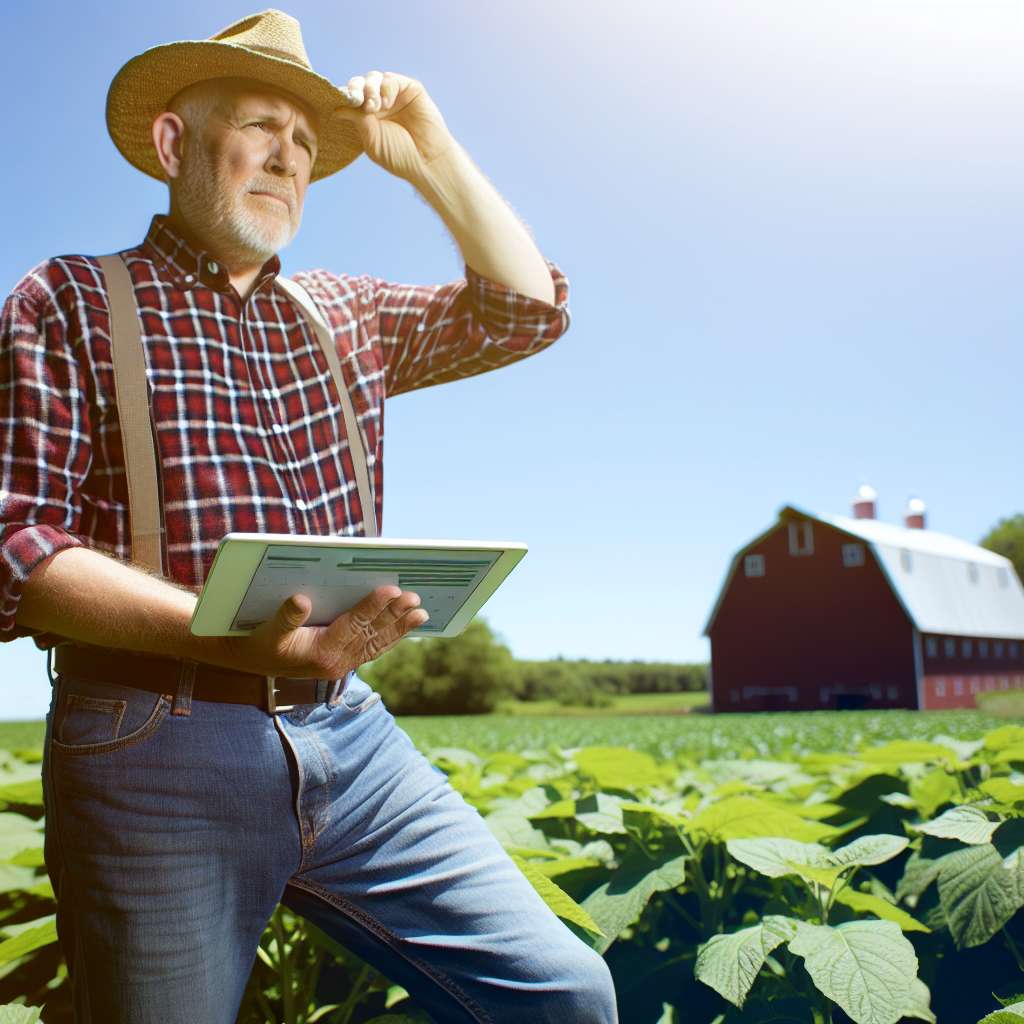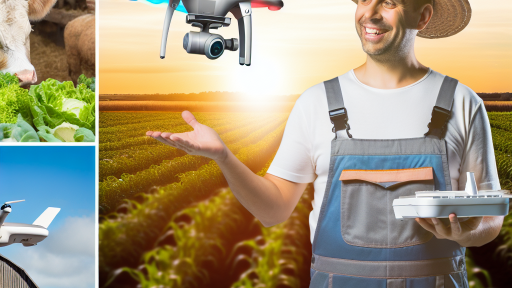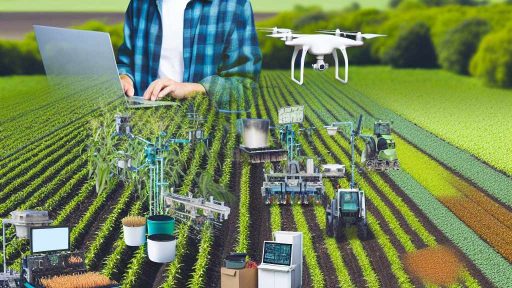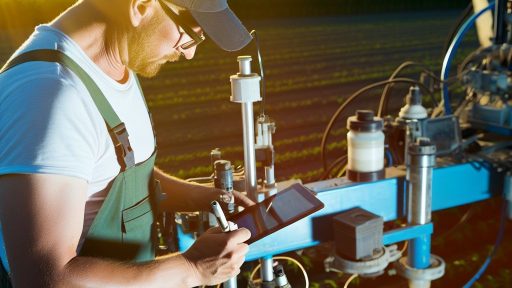Overview of Irrigation in Agriculture
Irrigation plays a crucial role in modern agriculture.
It ensures crops receive adequate water for optimal growth.
Farmers depend on effective irrigation techniques to enhance productivity.
Without irrigation, many regions would struggle with food production.
Additionally, irrigation directly impacts the sustainability of farming.
Importance of Irrigation
Irrigation significantly increases crop yields.
It helps mitigate the effects of drought and climate variability.
Consequently, farmers can achieve a more consistent harvest.
Moreover, irrigation supports a diverse range of crops.
It enables farmers to cultivate high-value crops, improving income.
Need for Efficient Water Management
Water scarcity is a pressing global issue.
Farmers must adopt efficient irrigation practices to conserve water.
In many areas, overuse of water resources is unsustainable.
Efficient systems can reduce waste and improve crop resilience.
Addressing water management helps secure food supply chains.
Transform Your Agribusiness
Unlock your farm's potential with expert advice tailored to your needs. Get actionable steps that drive real results.
Get StartedEconomic Benefits of Irrigation
Reducing irrigation costs can significantly impact farming profitability.
Farmers can lower operational costs through advanced irrigation methods.
Investing in efficient irrigation technology yields long-term savings.
Additionally, reliable irrigation minimizes losses during dry spells.
This approach ultimately enhances the overall economic viability of farms.
Types of Irrigation Systems: A Comparison of Efficiency
Drip Irrigation
Drip irrigation delivers water directly to the roots of plants.
This method minimizes water wastage through evaporation and runoff.
Additionally, it promotes healthy crop growth by providing consistent moisture.
Farmers often see a significant reduction in water usage compared to traditional methods.
Furthermore, drip irrigation can improve crop yields across various soil types.
Sprinkler Irrigation
Sprinkler irrigation distributes water through a system of pipes and pumps.
This method mimics natural rainfall over agricultural fields.
While it is adaptable to different crops, its efficiency can vary.
Wind and evaporation can lead to water loss in this system.
Regular maintenance is essential to ensure optimal performance.
Surface Irrigation
Surface irrigation involves flooding fields with water and allowing it to soak in.
This method is cost-effective but can waste water if not managed properly.
Soil type and slope play crucial roles in its effectiveness.
Farmers must monitor weather conditions and adjust water levels accordingly.
While easy to implement, skilled management is necessary for efficiency.
Subsurface Irrigation
Subsurface irrigation places water below the soil surface using buried tubes.
This method significantly reduces evaporation compared to surface methods.
It also minimizes weed growth since the surface remains dry.
However, initial installation costs can be high for farmers.
Showcase Your Farming Business
Publish your professional farming services profile on our blog for a one-time fee of $200 and reach a dedicated audience of farmers and agribusiness owners.
Publish Your ProfileProper system design ensures efficient water distribution to crops.
Comparative Efficiency of Irrigation Systems
Each irrigation system has unique advantages and disadvantages.
Drip irrigation is often recognized for its water-saving capabilities.
Sprinkler systems offer flexibility but can be less efficient in certain conditions.
Surface irrigation is low-cost but requires careful management to avoid waste.
Subsurface irrigation may have high upfront costs but can save water long-term.
Ultimately, the best choice depends on crop type, local climate, and budget.
Drip Irrigation: Benefits and Cost-Effectiveness
Overview of Drip Irrigation
Drip irrigation delivers water directly to plant roots.
This method maximizes water efficiency and minimizes waste.
Farmers can adjust the water flow to meet crop needs.
Benefits of Drip Irrigation
One major benefit is reduced water usage.
Farmers often save between 30% and 50% of water.
Additionally, it reduces labor costs compared to traditional irrigation.
With less manual labor, farmers can invest time in other tasks.
Improved Crop Yields
Drip irrigation enhances crop quality and yields.
It promotes steady moisture levels, leading to healthier plants.
As a result, farmers enjoy better harvests.
Weed and Pest Control
This irrigation method minimizes weed growth.
Weeds typically thrive on overwatering, which drip irrigation prevents.
Consequently, farmers spend less on herbicides and pesticides.
Cost-Effectiveness of Drip Irrigation
While installation can be expensive, savings accumulate over time.
Reduced water bills provide immediate financial relief.
Moreover, fewer resources for pest control lower agricultural costs.
Long-Term Investment
Drip irrigation systems can last over a decade.
Farmers should consider this technology as a long-term investment.
Consequently, they can recover initial costs through savings.
Government Incentives
Many governments offer subsidies for modern irrigation technologies.
Farmers can take advantage of these programs to offset costs.
This additional financial support makes drip irrigation more accessible.
Uncover the Details: Enhancing Farm Efficiency Through Supply Chain Optimization
Sprinkler Irrigation: Innovations and Efficiency Tips
Understanding Sprinkler Systems
Sprinkler systems provide a versatile solution for modern agriculture.
They deliver water directly to crops, enhancing growth efficiency.
Additionally, they minimize water wastage compared to traditional methods.
Types of Sprinkler Systems
There are several types of sprinkler systems available today.
Drip irrigation offers precision watering to individual plants.
Center pivot systems cover large agricultural fields effectively.
Moreover, stationary and portable systems are suitable for various farm sizes.
Innovations in Sprinkler Technology
Recent advancements have improved the efficiency of sprinkler systems.
Smart irrigation controllers optimize water usage based on weather conditions.
Consequently, farmers can save both water and money.
Showcase Your Farming Business
Publish your professional farming services profile on our blog for a one-time fee of $200 and reach a dedicated audience of farmers and agribusiness owners.
Publish Your ProfileFurthermore, sensor technology detects soil moisture levels accurately.
Efficiency Tips for Sprinkler Irrigation
Optimizing your sprinkler system maximizes crop yield and reduces costs.
Adjust your sprinkler heads to prevent water runoff.
Regular maintenance keeps the system running efficiently.
Additionally, scheduling watering during cooler hours minimizes evaporation.
Economic Benefits of Efficient Sprinkler Use
Using an efficient sprinkler system significantly reduces farming costs.
Lower water consumption translates to decreased utility bills.
Furthermore, healthier crops lead to better harvests and increased profits.
Ultimately, investing in modern technology pays off in the long run.
Explore Further: Budgeting Tips For Sustainable Farming Practices
Soil Moisture Sensors: Enhancing Water Management
Introduction to Soil Moisture Sensors
Soil moisture sensors play a critical role in modern agriculture.
They help farmers monitor water levels in the soil effectively.
This technology promotes efficient irrigation methods.
How Soil Moisture Sensors Work
Soyl moisture sensors measure the volumetric water content of the soil.
They provide real-time data to farmers.
Using this data allows farmers to make informed irrigation decisions.
Benefits of Using Soil Moisture Sensors
- Save water by preventing over-irrigation.
- Improve crop yields through optimal water usage.
- Reduce labor costs by automating irrigation systems.
- Enhance soil health by preventing erosion and nutrient loss.
Integrating Soil Moisture Sensors into Farming Practices
Farmers can integrate sensors with existing irrigation systems.
This synergy allows for automated watering based on soil needs.
Additionally, farmers can utilize mobile applications to track moisture levels.
Case Study: Successful Implementation
The Green Valley Farm adopted soil moisture sensors in 2022.
After implementation, they reported a 30% reduction in water usage.
Moreover, crop yields increased by 15% due to precise irrigation.
Future Trends in Soil Moisture Sensing
Advancements in technology will enhance sensor accuracy.
Integration with AI will enable predictive analytics for irrigation.
As a result, farmers will benefit from even greater resource efficiency.
See Related Content: Maximizing Crop Yields While Minimizing Costs

Rainwater Harvesting: Strategies and Implementation
Overview of Rainwater Harvesting
Rainwater harvesting collects rainwater for agricultural use.
This method reduces reliance on conventional water sources.
Farmers can enhance water availability during dry seasons.
Furthermore, rainwater is often free of chemicals.
Gathering Rainwater
Farmers can use roofs to collect rainwater effectively.
Through downspouts, water flows into storage containers.
Utilizing cisterns allows for large capacity storage.
Implementing proper filtration ensures clean water for crops.
Utilizing Collected Water
Farmers can distribute harvested rainwater through irrigation systems.
Drip irrigation maximizes efficiency by targeting plant roots.
This method minimizes water wastage significantly.
Additionally, farmers can integrate rainwater with existing systems.
Site Selection and Design
Choosing the right site influences rainwater harvesting success.
Adequate slopes aid in maximizing water collection.
Showcase Your Farming Business
Publish your professional farming services profile on our blog for a one-time fee of $200 and reach a dedicated audience of farmers and agribusiness owners.
Publish Your ProfileDesigning storage systems according to local rainfall patterns is vital.
Cost and Maintenance Considerations
Initial setup costs can vary depending on system complexity.
However, long-term savings often offset these expenses.
Regular maintenance ensures the system operates efficiently.
Case Studies and Success Stories
Many farmers have seen success using rainwater harvesting.
For instance, Maria’s farm in Arizona increased yield by 30%.
Additionally, John’s vineyard now thrives using collected rainwater.
Such examples demonstrate the potential of this approach.
Uncover the Details: Investment Strategies To Sustainably Grow Your Farming Business
Integration of Renewable Energy in Irrigation Systems
Overview of Renewable Energy Sources
Solar energy stands as a powerful option for irrigation systems.
Wind energy also provides an efficient alternative for powering pumps.
Biomass can convert organic materials into energy for agricultural use.
These sources promote sustainability and reduce dependency on fossil fuels.
Benefits of Renewable Energy in Irrigation
Renewable energy lowers overall farming costs significantly.
It reduces long-term operational expenses for irrigation systems.
Farmers enjoy increased control over their energy sources.
Moreover, this integration enhances environmental resilience.
Implementing Solar Irrigation Systems
Solar irrigation systems convert sunlight into energy for water pumping.
This method greatly decreases reliance on grid electricity.
Farmers can install solar panels on-site for convenience.
The technology is continually advancing, making it more accessible.
Utilizing Wind Energy for Irrigation
Wind turbines can generate power to operate irrigation pumps.
Optimal wind farm locations often coincide with farmland.
This dual-use of land maximizes renewable energy capture.
Wind energy offers a stable and sustainable irrigation solution.
Cost Efficiency and Return on Investment
Initial setup costs can be offset by long-term savings.
Government incentives often encourage the adoption of renewable systems.
Farmers can expect a high return on investment over time.
Additionally, increased energy independence leads to greater profitability.
Challenges and Considerations
Upfront investment in renewable systems can be significant.
Maintenance and equipment monitoring remain crucial for efficiency.
Furthermore, weather variability affects energy generation capabilities.
Farmers should assess local resources to determine feasibility.
Real-Life Examples of Successful Integration
Benson Farms successfully implemented a solar-powered irrigation system.
They reported a 40% decrease in energy costs within the first year.
Greenfield Acres optimized wind energy, seeing a 30% boost in productivity.
Such examples highlight the potential benefits of renewable energy in farming.
Government Incentives and Programs for Efficient Irrigation Solutions
Understanding Available Incentives
Governments offer various incentives to promote efficient irrigation practices.
These incentives aim to reduce water consumption and improve crop yields.
Farmers can benefit from both financial support and technical assistance.
Showcase Your Farming Business
Publish your professional farming services profile on our blog for a one-time fee of $200 and reach a dedicated audience of farmers and agribusiness owners.
Publish Your ProfileMoreover, understanding the types of programs available is crucial for farmers.
Types of Government Programs
There are many types of government programs supporting efficient irrigation.
- Subsidies for purchasing modern irrigation equipment.
- Grants for implementing sustainable water management practices.
- Tax credits for investing in water-saving technologies.
These programs help lower the cost burden on farmers.
Additionally, they encourage adoption of advanced irrigation methods.
Benefits for Farmers
Participating in these programs can lead to significant savings.
Farmers often see reductions in water usage and operating costs.
Increased crop production also results from optimized irrigation techniques.
Furthermore, these solutions contribute to better environmental outcomes.
Eligibility Criteria and Application Process
Eligibility for programs varies based on location and type of farm.
Farmers should check local government resources for specific criteria.
Applying is often straightforward, requiring basic farm information.
Additionally, attending workshops can provide valuable guidance.
Examples of Successful Programs
Several states have implemented successful irrigation programs.
For instance, California’s Sustainable Agricultural Lands Conservation Program supports farmers.
This program offers incentives for water-efficient technologies.
Another example is New Mexico’s Irrigation Efficiency Program, which provides grants.
Future Directions and Innovations
Looking ahead, government initiatives are expected to evolve.
Emerging technologies like precision irrigation will gain more focus.
Additionally, policies will likely adapt to address climate change impacts.
Sustainable water management will be a priority for policymakers.
Additional Resources
Rural Energy for America Program Renewable Energy Systems …
Towards nutrient neutrality: A review of agricultural runoff mitigation …




